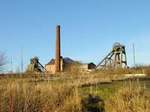
Technical > Engine-houses
Section under development
Contents:
The engine-houses sit back-to-back between the two shafts with transverse wings linking them. The original walls are 24in thick, rubble cored, with external facings of random quarry-faced ashlar and internal facings of lime-washed uncoursed stone. At some time after 1904 the interior walls of the North engine-house were smooth rendered although some of this came away when the engine-house was open to the elements in the 1990s. The gable-ends were capped with sawn coping slabs, many of which remain in use as kneelers, still showing the original saw marks.
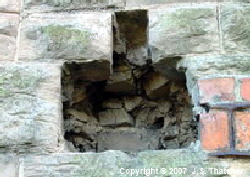
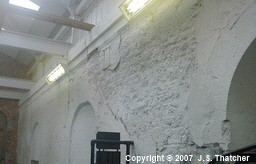
Original engine-house wall construction. The girder insertion is 20th century.
North engine-house inside wall with section of later rendering removed
The facing stone of the engine-houses is magnesian sandstone, probably from the Mansfield quarries, most of which has weathered to a light grey colour. When the South engine-house was enlarged in 1922, additional darker coloured gritstone blocks were incorporated in the upper sections.
The original mortar was lime based, the lime being obtained from the yellow magnesian limestone bed-rock quarried and burnt on site. This gives it a distinctive creamy colour, quite different from the later dark cement and clinker based mortars and the more recent pale sand and cement ones. This enables the sections with original masonry to be easily identified and allows approximate dating of other areas
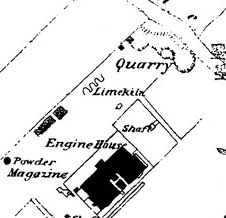
1875 1:2500 map detail
The original slated roofs were of traditional timber construction, using a jointed-cruck arrangement. Common-rafters were carried on purlins supported by fabricated principle-rafters braced by wall-posts elbowed at wall-plate level with collar-beams supporting king posts beneath the ridge. Strong cross timbers ran between the side walls although it is not clear whether these acted as tie-beams or were merely to provide support for lifting gear. The wall-posts rested on stone corbels adjacent to the window reveals. These were removed from the North engine-house, probably when the roof was altered in the 1960s although their location can still be made out together with the outline of the wall-post at one window. The junction of the engine-house and transept ridges was surmounted by a louvered ventilator.
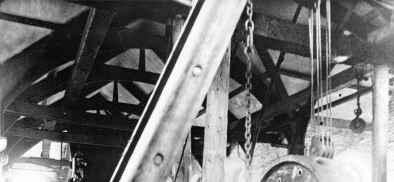
South engine-house and west-wing roof timber construction circa 1904 (FoPP/JST)
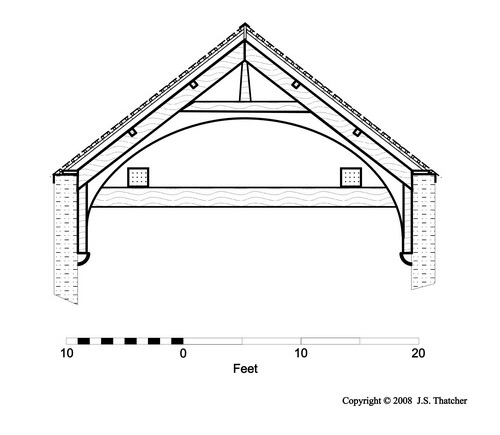
Engine-house roof construction circa 1904
At some point after the mid 1880s, cross-ties had to be fitted to the side walls of both engine-houses at the gable ends. These consisted of 2in square iron bars extending through both side-walls into outside anchor plates. These can still be seen on the North engine-house walls although the internal section of the tie-bar was removed when larger brakes were installed and only a stub remains.
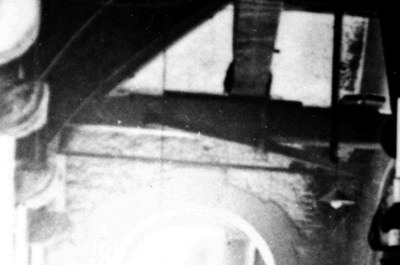
South engine-house joists and iron tie-bar circa 1904 (FoPP/JST)
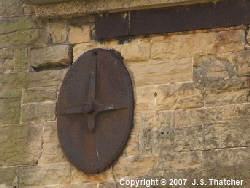 |
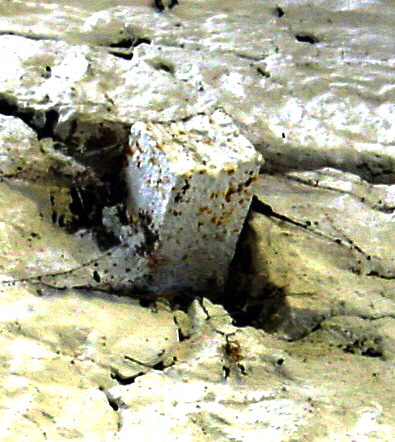 |
||||||||
|
North engine-house West wall tie-bar anchor plate |
North engine-house West wall tie-bar stub |
||||||||
|
The windows were round arched with the internal reveals slightly flared. The reveal dentils, voussoirs and keystone were of dressed ashlar sandstone with the internal faces smooth sawn and the outside rock-faced with sawn arrisses. The external arriss line was continued for an inch or so into the slope of the rock-faced sill. The North engine-house still retains its original window reveals (and possibly the original timber frames). |
|||||||||
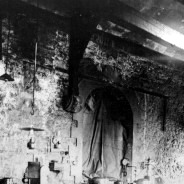
South engine-house inside wall circa 1904 (FoPP/JST)
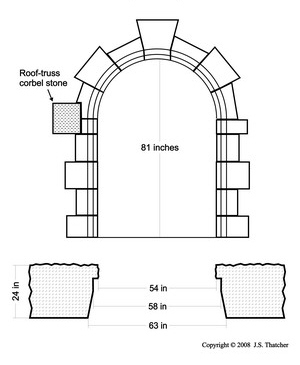
Engine-house side window reveal details
Below the window of the transept east wing, there appears to have been two smaller rectangular windows. These can be seen in an etching from the mid-1880s and traces of the right-hand one can still be made out. The sill of these windows would have been floor level inside the engine-house and their purpose is unclear.
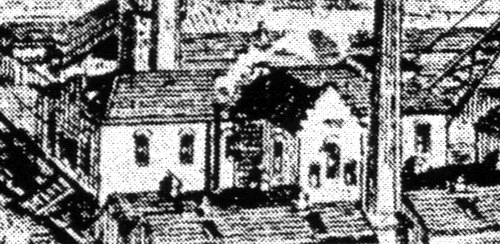
Engine-house layout circa 1885. Note the different arrangements of the engine-house gable ends. (JST)
The end walls of both engine-houses were of quite different designs. Both roofs had hipped gables, with a low dormer rope entry faced with an arched stone wall on the South. Below this can be seen the entry for the underlap winding rope, the timber lintel of which was still in situ above the blocked entry until the wall was rebuilt in 1922. The North engine-house roof, however, was surmounted by a raised section extending several feet back along the ridge from the hip. This was a modification needed to accommodate the overlap winding rope entering at a higher level due to the ?unplanned location of the original winding drum at the back end of the engine-house.
In 1901 the North engine-house had a stepped gable end, with the parapet stonework taken up to the ridge in four lifts, each capped with a horizontal coping slab. The ridge parapet was arched and capped with curved coping stones. The overlap rope still entered through the roof via the wooden hutch on the ridge further back, whilst the underlap rope entered at a high level in the gable end wall. The asymmetric window arrangement is puzzling and the windows themselves were of different sizes. There was also a rectangular opening near ground level, positioned a few feet to the left of the centre line, the function of which is not yet understood.
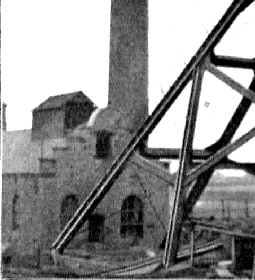
North engine-house June 1901 with the overlap ropes entry on the ridge still in use. The oval plate of the wall tie can just be made out on the side wall below the end of the eaves. The corner piece of the concealed rainwater channel system is still in-situ under the stonework of the first step of the gable wall capping. (JST)
Another puzzling asymmetry of the original engine-house layout was in the width of the two projecting transept wings. For some reason, the wing on the east side was narrower than that on the west. This can be seen on the 1:2500 maps and is confirmed in the plan on the right drawn by the manager, G. A. Longden, in 1901.
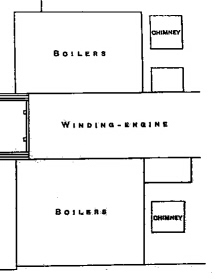
North engine-house and boiler layout circa 1901 (JST)
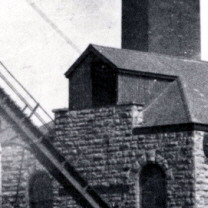
South engine-house end wall circa 1910 with a half-hipped gable-end The edge of the wall-tie plate can just be seen just below centre right-hand edge. Note the timber lintel of the original underlap rope entry which has now been walled up. (FoPP/JST)
By around 1910, the South engine-house now had a simple wooden dormer window entry for the overlap rope supported by a low central wall just above eaves height. The slates on the two hipped sections are much smaller than those of the main roof, and it is probable that this was a modification resulting from the installation of the larger winding drum in 1900. Unlike at the North engine-house, the South end-wall windows seem more symmetrically and there appears to be have been a glazed door fitted in the lower part of the east window. It is quite possible that the original curved coping stones from the South gable end may have been re-used on the North engine-house.
When the North winder was renewed in 1904-5, the replacement was positioned such that both overlap and underlap ropes ran out through the end wall. The curved coping on the gable end was replaced with a pair of inclined slabs. Why the gable was altered is unknown- possibly the curved coping stones were damaged, although when the gable end of the South engine-house was rebuilt in 1922 this was terminated with arched coping - perhaps they were the same stones.
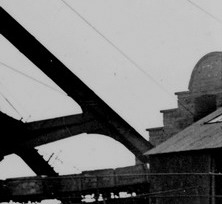
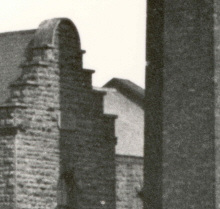
Front view of North engine-house gable-end - 1901 - 1904 (FoPP/JST)
Rear view of North engine-house gable-end post 1904 (FoPP/JST)
In 1922 the South engine-house was rebuilt to accommodate a larger winder. It was both heightened and widened - slightly on the east side and by several feet on the west. In order to accommodate the widening, the boilers on the SW and SE sides of the engine-house were removed and new ones installed further away from the SE wall. When this had been done, the foundations and footings were laid and the lower sections of the side walls were built up to ground level.
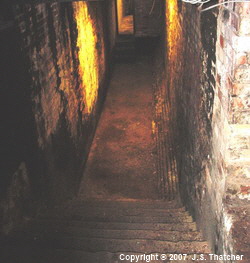
South engine-house west side lower wall footings
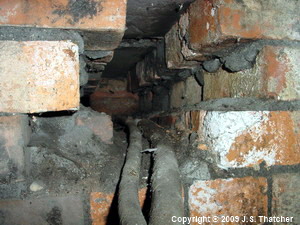
South engine-house lower wall construction
Once the shaft deepening had been completed and a temporary winder installed, work on constructing the new engine-house could proceed. The original east and west walls were completely demolished, with the facing stone being reused for the new walls above ground level. The lower parts of the wings and the end wall were left in place but widened where necessary. A small sections of the original SW corner of the engine-house can be seen in the basement and in the exhaust tunnel above the outside cross-flue, whilst the original corbel stones for the raking legs of the pre-1900 wooden headstock are still in-situ. A new internal dividing wall with a large doorway and metal framed windows was built between the two engine-houses as part of the enlargement.
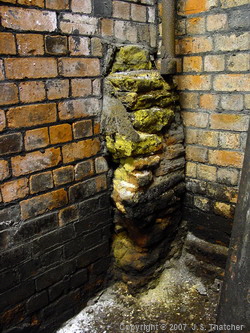
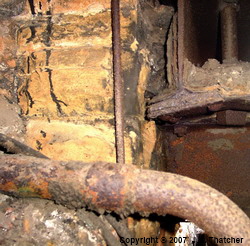
Original South engine-house RH-corner stonework with the headstock raking-leg foot girders
Original South engine-house RH-corner stonework in the basement
Both wings were raised and the east wing was widened to match the west. The two middle crow-step parapets of the gable-ends of both wings were replaced with plain inclined coping slabs. Once again, the engine-house asymmetry appeared, although rather more subtly. The original date stones were added to, but by a different hand on each side. In addition, difference in height of about two courses of bricks is seen on the gable ends of the two wings.
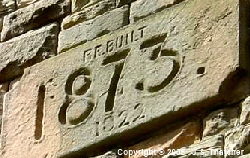
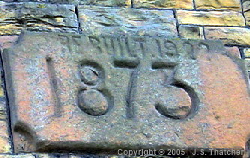
South engine-house east wing date-stone
South engine-house west wing date-stone
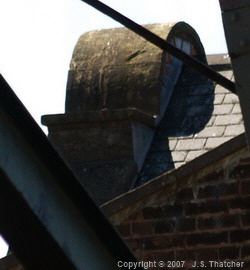
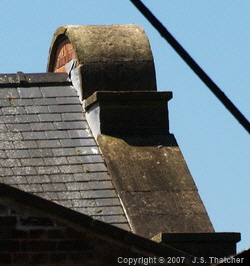
South engine-house east wing gable-end coping-stones
South engine-house west wing gable-end coping-stones
The end-wall gable was finished in the same style as the wings but with the addition of a stone bearing the year and six sets of initials, four of which are known whilst the other two are yet to be identified.
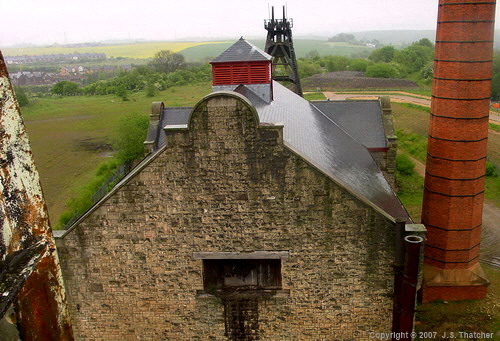
South engine-house gable-end coping-stones
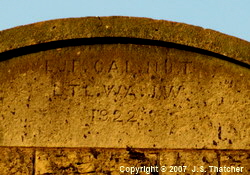
South engine-house end wall name-stone
In the mid 1960s, the original slate roof of the North engine-house was replaced with an asbestos sheet covering which raised the ridge line a few inches and the eaves by several feet. The end wall was also rebuilt at this time using brickwork. When the colliery closed the roof on the North engine house was completely removed leaving the interior and the winder exposed to the elements. When the restoration began, a temporary cover was installed until the roof could be recovered using modern profiled steel sheeting to reproduce the 1960’s roof lines.
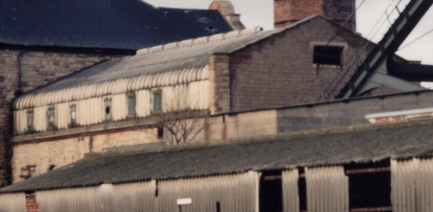
North engine-house post-1966 roof and end wall (FoPP/JST)
As a result of the new roof, the transition from the 1922 brick internal dividing wall between the two engine-houses, and its stone-faced external continuation above the roof of the North engine-house can clearly be seen.
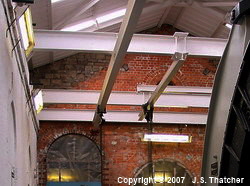
North engine-house dividing wall - post 1966
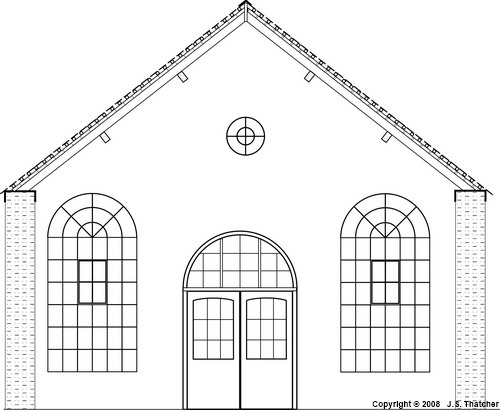
North engine-house dividing wall 1922 - 1966
The asymmetry appears once again in the dividing wall where the tall windows and the doorway are slightly off-centre although the round window at an higher level is on-centre.
Yet to do:
- E wing early low-level hatchway traces
- E wing original doorways - access to E boilers
- Eng-hse side combined wall-plates / guttering & down-spouts
- N eng-hse end wall window and doorway arrangement 1901, 1966
- N eng-hse original floor level pre-1904
- N eng-hse W side annexe ? 1911 turbine generator
- N eng-hse rendering and glazed tiles:
- E & W wing doorway alterations 1921
- E & W wing window alterations 1921
- S eng-hse end wall E doorway replaced by window frame 1921
- S eng-hse end wall W window replaced by doorway to pit top 1921
- S eng-hse rope exit weather curtains & sunlight screen
- S eng-hse W side doorway construction 1950s ? 1960s
- S eng-hse end wall air-lock - post 1950s pit-top modernisation
- S eng-hse toilet & washing facilities
Sources
- Friends of Pleasley Pit photographic archive
- Stanton and Stavely, A Business History, S.D. Chapman
- Longden, G.A., Trans. Fed. Inst. Min. Eng. Vol XXIII, 1901-02
- 25 inch Tithe Maps, 1875, 1899, 1916, 1938 (Derbyshire County Records Office)
- Stanton Ironworks Co. Technical Reports, 1921, 1922 (Derbyshire County Records Office)
Copyright © 2005 - 2020 J.S. Thatcher
Page updated on:
30 Jul, 2020
at
01:20:34 PM
In case of problems contact: